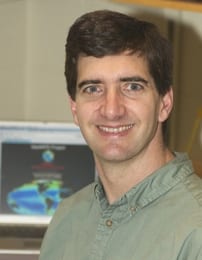Earth’s Ability to Absorb Increased Carbon Emissions May Be Limited
August 16, 2005
The ability of both land and sea to absorb increased emissions of carbon dioxide is limited, according to a recent study using a new computer model of Earth’s climate that takes into account the planet’s carbon cycle. The new generation climate model indicates land and ocean will absorb less carbon, much of it from the burning of fossil fuels, in the future if current trends continue, and that could mean significant shifts in the climate system.
Scott Doney, a Woods Hole Oceanographic Institution (WHOI) geochemist and co-author of the report published in the August 9, 2005 issue of the Proceedings of the National Academy of Sciences, says the new computer model filled in some important details about the uptake of carbon from the atmosphere, and will enable other climatologists to address many related questions.
“Time is of the essence in dealing with greenhouse gas emissions,” Doney said. “We can start now or we can wait 50 years, but in 50 years we will be committed to significant rapid climate change, having missed our best opportunity for remediation.” Doney says the team’s study demonstrates that the earth’s ability to soak it up and store it in its natural reservoirs, or sinks, is inversely related to the rate at which carbon is added to the atmosphere. In short, the sooner we slow down gas emissions, the easier it will be for the Earth’s natural processes to help solve the problem.
Most scientists agree that adding anthropogenic or human-produced greenhouse gases, like carbon dioxide, to the atmosphere is contributing to an increase in global temperatures. The land and oceans currently absorb about half of the carbon dioxide produced by human activity, and some scientists believe both will continue to remove carbonthrive as emissions increase. However, the new study suggests that land and oceans can absorb carbon at a certain rate, and at some point they may not be able to keep up.
Changes in climate will lead to other changes, like rising sea levels and vanishing habitats. The earth is a complicated system, however, and the details of how global warming feeds into the system as a whole are not yet well understood.
Doney, a senior scientist in the Marine Chemistry and Geochemistry Department, says one of the most unique and exciting aspects of the study is the linkage of the earth’s carbon cycle to model projections of future climate behavior. Carbon-based gases have long been known to play a major role in global warming, but until now researchers have been unable to incorporate carbon’s activity in non-atmospheric parts of the earth system into science’s understanding of climate change.
Doney and collagues conducted experiments that looked at ecosystems, which are major carbon repositories, as an influence on climate change. Previous work had focused mainly on the physical and chemical pieces of the puzzle because older models could not factor in biological considerations.
“We’re saying that ecosystems are an additional feedback mechanism that might be as important as physical feedbacks” said Doney, who has served on many national and international committees on the global carbon cycle. “The new model will facilitate research into that question, and hopefully provide insights into the earth’s workings that will help humanity solve a problem that greatly affects us all.”
Doney’s work was supported by the WHOI Ocean and Climate Change Institute and the National Science Foundation. Scientists from the University of California, Berkeley, and the National Center for Atmospheric Research participated the study.

